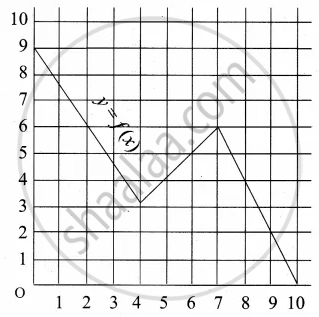Advertisements
Advertisements
प्रश्न
Solve for x.
2 log10 x = `1 + log_10 (x + 11/10)`
उत्तर
2 log10 x = `1 + log_10 (x + 11/10)`
∴ `log_10 x^2 - log_10 (x + 11/10)` = 1 ...[n log m = log mn]
∴ `log_10 x^2 - log_10((10x + 11)/10)` = 1
∴ `log_10 (x^2/((10 x + 11)/10))` = 1 ...`[log"m" - log "n" = log "m"/"n"]`
∴ `log_10 ((10x^2)/(10x + 11))` = log10 10 ...[∵ loga a = 1]
∴ `(10x^2)/(10x + 11)` = 10
∴ `x^2/(10x + 11)` = 1
∴ x2 = 10x + 11
∴ x2 – 10x – 11 = 0
∴ (x – 11)(x + 1) = 0
∴ x = 11 or x = – 1
But log of negative number does not exist
∴ x ≠ – 1
∴ x = 11
APPEARS IN
संबंधित प्रश्न
Find the domain of the function f(x) = `(x^2 + 2x + 1)/(x^2 - 8x + 12)`
If \[f\left( x \right) = x^3 - \frac{1}{x^3}\] , show that
If for non-zero x, af(x) + bf \[\left( \frac{1}{x} \right) = \frac{1}{x} - 5\] , where a ≠ b, then find f(x).
If f(x) = 4x − x2, x ∈ R, then write the value of f(a + 1) −f(a − 1).
Let A and B be two sets such that n(A) = p and n(B) = q, write the number of functions from A to B.
Let A = {1, 2, 3} and B = {2, 3, 4}. Then which of the following is a function from A to B?
Let A = {x ∈ R : x ≠ 0, −4 ≤ x ≤ 4} and f : A ∈ R be defined by \[f\left( x \right) = \frac{\left| x \right|}{x}\] for x ∈ A. Then th (is
The domain of definition of \[f\left( x \right) = \sqrt{\frac{x + 3}{\left( 2 - x \right) \left( x - 5 \right)}}\] is
If \[\left[ x \right]^2 - 5\left[ x \right] + 6 = 0\], where [.] denotes the greatest integer function, then
If f(m) = m2 − 3m + 1, find f(− x)
Which of the following relations are functions? If it is a function determine its domain and range:
{(1, 1), (3, 1), (5, 2)}
If f(x) =` (2x−1)/ (5x−2) , x ≠ 2/5` Verify whether (fof) (x) = x
If f(x) = `{(x^2 + 3"," x ≤ 2),(5x + 7"," x > 2):},` then find f(0)
Check if the following relation is a function.

lf f(x) = 3(4x+1), find f(– 3)
Express the following exponential equation in logarithmic form
3–4 = `1/81`
Express the following exponential equation in logarithmic form
10−2 = 0.01
Find the domain of f(x) = ln (x − 5)
Write the following expression as sum or difference of logarithm
In `[(root(3)(x - 2)(2x + 1)^4)/((x + 4)sqrt(2x + 4))]^2`
Solve for x.
log2 + log(x + 3) – log(3x – 5) = log3
The equation logx2 16 + log2x 64 = 3 has,
Answer the following:
Identify the following relation is the function? If it is a function determine its domain and range
{(12, 1), (3, 1), (5, 2)}
Answer the following:
Find the domain of the following function.
f(x) = 5–xPx–1
Answer the following:
Find (f ° g) (x) and (g ° f) (x)
f(x) = `x/(x + 1)`, g(x) = `x/(1 - x)`
A graph representing the function f(x) is given in it is clear that f(9) = 2

Describe the following Range
A function f is defined by f(x) = 3 – 2x. Find x such that f(x2) = (f(x))2
The data in the adjacent table depicts the length of a person's forehand and their corresponding height. Based on this data, a student finds a relationship between the height (y) and the forehand length (x) as y = ax + b, where a, b are constant.
| Length ‘x’ of forehand (in cm) |
Height 'y' (in inches) |
| 35 | 56 |
| 45 | 65 |
| 50 | 69.5 |
| 55 | 74 |
Find the height of a person whose forehand length is 40 cm
The range of the function f(x) = `(x^2 - 3x + 2)/(x^3 - 4x^2 + 5x - 2)` is ______
If f(x) = `1/sqrt(4 - 3x)`, then dom(f) = ______..
Redefine the function which is given by f(x) = `|x - 1| + |1 + x|, -2 ≤ x ≤ 2`
Let f and g be two functions given by f = {(2, 4), (5, 6), (8, – 1), (10, – 3)} g = {(2, 5), (7, 1), (8, 4), (10, 13), (11, – 5)} then. Domain of f + g is ______.
Find the domain of the following functions given by f(x) = x|x|
Find the range of the following functions given by f(x) = `3/(2 - x^2)`
Let f(x) = `sqrt(x)` and g(x) = x be two functions defined in the domain R+ ∪ {0}. Find (f – g)(x)
Range of f(x) = `1/(1 - 2 cosx)` is ______.
The domain and range of the function f given by f(x) = 2 – |x – 5| is ______.
The domain for which the functions defined by f(x) = 3x2 – 1 and g(x) = 3 + x are equal is ______.
The range of the function y = `1/(2 - sin3x)` is ______.
The domain of the function f(x) = `1/sqrt(|x| - x)` is ______.
Let f(θ) = sin θ (sin θ + sin 3θ) then ______.
